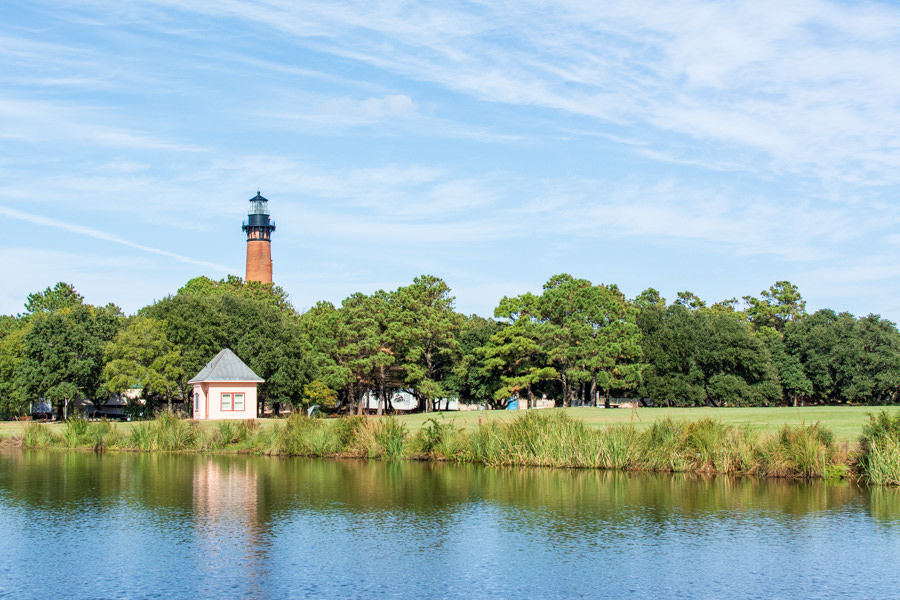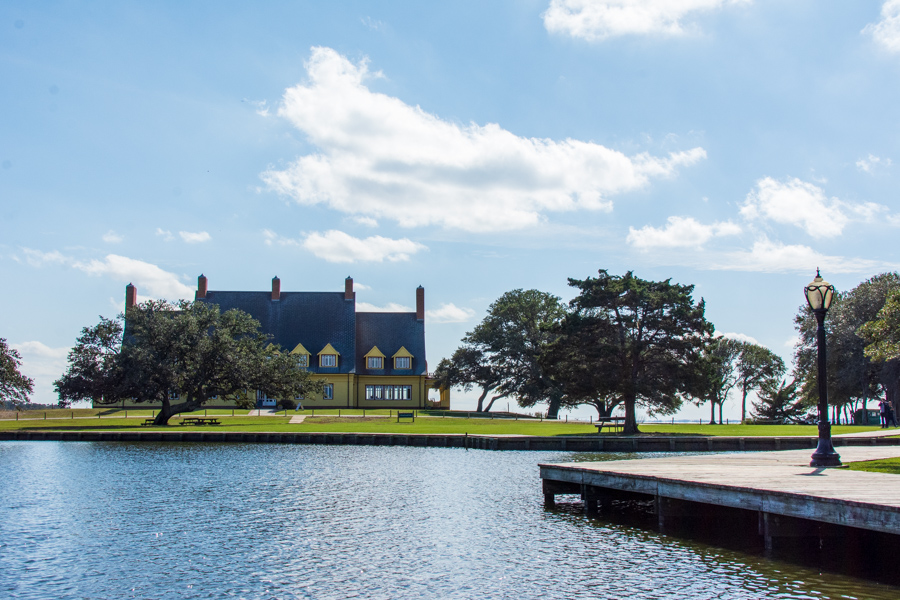North Carolina’s Outer Banks is wildly popular and with good reason. The barrier islands have miles of unspoiled beaches that visitors flock to each year. Some of my best memories of the Outer Banks weren’t spent in the sand, but also exploring the region, with each of its small towns adding a unique feel.
Maybe you’re not a beach person, or you’re looking to visit during the off-season or shoulder-season; maybe you’re looking for things to do in the Outer Banks on a rainy day, or you’re looking for free things to do. No matter the reason, there are plenty of fun things to do in the Outer Banks besides the beach, from the lighthouses to the region’s rich history!
Climb to New Heights: The Iconic Lighthouses
There are five lighthouses along the Outer Banks’ coast.
- Currituck Beach Lighthouse in the north
- Ocracoke Island Lighthouse in the south
- Roanoke Marshes Lighthouse in Manteo on Roanoke Island
- Bodie Island Lighthouse in South Nags Head
- Cape Hatteras Lighthouse in Buxton
Depending on the time of year (and barring construction), Currituck Beach, Bodie, and Cape Hatteras are open to the public and can be climbed. But you don’t need to go to the top of the lighthouses to enjoy them. Visitors can explore the grounds, marvel at their height, and learn about the important job they have, even today.
Currituck Beach Lighthouse in Corolla stands out with its unpainted red brick exterior nestled amongst the evergreens in charming Historic Corolla Village. Bodie Island is particularly captivating, surrounded by a marsh with a boardwalk that offers excellent opportunities for nature viewing. Cape Hatteras, perhaps the most famous of the bunch with its black and white candy swirl, is the tallest brick lighthouse in North America and offers stunning views over the Atlantic Ocean.
Go Wild: Outer Banks Nature & Wildlife Encounters
Explore Jockey’s Ridge State Park (Nags Head)
It’s difficult to miss Jockey’s Ridge State Park. The 427-acre park in Nags Head is the tallest living sand dune system on the Atlantic Coast. It’s a popular spot for hang gliding, kite flying, and simply exploring. Some trails through the park are sure to give you a workout, as you climb the often steep, loosely packed sand dunes. It’s also dog-friendly, although it’s important to be mindful of the temperature of the sand on delicate paws.
Kayak or Paddleboard on the Sound
While everyone is clamoring for the crash of the waves, on the sound side of the Outer Banks, everything is just a bit calmer. The shallow waters are perfect for just getting your toes wet, with patches only ankle-deep. Or, elsewhere, you can kayak or paddleboard on the smooth waters while enjoying the frequent sight of herons and other wildlife.
Hike Nags Head Wood Nature Preserve
Tucked away behind a local neighborhood is Nags Head Wood Nature Preserve. The preserve is a hotbed of wildlife with more than 100 different varieties of birds passing through, in addition to turtles, lizards, and other mammals and reptiles.
The site offers more than eight miles of walking trails, many through wooded areas, past marshes, across dune ridges, and around ponds.
If hiking isn’t your thing, enjoy the boardwalk area at the visitor center overlooking a marsh. The site offers a special serenity that will make you forget you’re at the beach!
Elizabethan Gardens
Mother Nature has something different to offer with each season at the Elizabethan Gardens on Roanoke Island. The botanical garden is open year-round (from February through December). The collection features a rose garden, camellias, a butterfly garden, and an ancient oak.
Step Back in Time For the History Buffs
Wright Brothers National Memorial
The Wright Brothers may have been the most famous tourists in OBX. But it didn’t start that way. Over the course of years, the Orville and Wilbur Wright traveled to Kitty Hawk to conduct experiments for their flying machine. In 1903, they succeeded when Orville flew 120 feet in a flight that lasted a mere 12 seconds. The world was changed forever.
Visitors can visit the Wright Brothers National Memorial and walk the grounds where the pair worked on their invention and finally took flight. As part of the national memorial, there’s a small but informative museum that includes a replica 1903 flyer. The park rangers also give free half-hour-long talks on the brothers.
The Wright Brothers monument, a 60-foot-tall granite tower with Art Deco details, sits atop a nearby hill and is worth a look at.
The Lost Colony & Fort Raleigh National Historic Site
In the late 16th century, the Roanoke Colony was England’s first established settlement in the New World. When the colony’s governor, John White, returned from England, the settlement (now known infamously as the Lost Colony) was abandoned within five years of its establishment.
About two centuries later, the Union Army occupied the site during the Civil War and established a Freedmen’s Colony.
Today, the area is Fort Raleigh National Historic Site, where visitors can walk in the footsteps of those prior settlements and see the archaeology that has been preserved.
Nearby, during the peak summer season, The Lost Colony stage production dramatizes the historic mystery. If you’re in town, it’s worth seeing the impressive staging set right along the waterfront.
Roanoke Island Festival Park
Nearby to Fort Raleigh is the Roanoke Island Festival Park. It’s part park, part museum, and part performance venue. In addition to a large lawn for picnics and hanging out, there is a stage that hosts shows from major musicians from around the country.
The Festival Park is also home to a museum about Roanoke Island and the region. Living history reenactors show visitors what life was like for the colonists before their settlement mysteriously vanished. The local indigenous population is also represented, too. On the sound, there’s also a full-size reproduction of a 16th-century sailing ship that visitors can board and explore.
Charming Towns & Rainy Day Rescues
North Carolina Aquarium on Roanoke Island
The North Carolina Aquarium on Roanoke Island is a classic spot to visit no matter the weather, but especially on a rainy day. The museum has an impressive collection of wildlife and is popular for its sea turtle rescue center. There are plenty of hands-on and immersive exhibits to engage kids as well as adults.
Walk the Duck Town Park Boardwalk
Instead of going for a walk on the beach, go for a stroll on the sound. The Duck Town Park Boardwalk is a one-mile-long boardwalk along the Currituck Sound that sneaks around and behind shops and restaurants. The waterfront area is full of wildlife with a range of birds stopping by to check out the tall grasses or for a bite of seafood.
The trail also offers access to fishing/crabbing points and kayak launches.
Explore Historic Manteo
Experience a true Southern small town in Historic Manteo. Set along the waterfront, the area is a mixture of historic buildings, a marina, and a collection of charming local boutiques and art galleries. Stroll the sidewalks, take in the atmosphere, and stop off for some lunch and shopping.
Historic Corolla Village
Historic Corolla Village, around the Currituck Beach Lighthouse, has plenty to explore. The landmark Art Deco mansion, the Whalehead Club, sits along the waterfront in Historic Corolla Park near a charming arched wooden bridge and a wildlife museum.
Closer to the lighthouse are a collection of small shops and restaurants, including Corolla Village BBQ (a favorite of mine), and the Currituck Maritime Museum, a small but impressive free attraction highlighting the local seafaring lifestyle that has survived for generations.
Know Before You Go: Tips for Your OBX Adventure
The Outer Banks is an increasingly popular destination, and a little planning goes a long way, especially when you’re exploring beyond the beach. Here are a few essential tips to help you make the most of your trip.
Check the Season and Hours
Many attractions in the Outer Banks are seasonal. The ability to climb lighthouses, for example, is generally available from spring through fall and is subject to weather conditions. In the off-season, some sites may have reduced hours or be closed entirely. It’s always a good idea to check the official website for an attraction before you drive there.
You’ll Need a Car
The Outer Banks are a series of long, narrow barrier islands. The attractions listed here are spread out from Corolla in the north to Roanoke Island and beyond. Public transportation is very limited, so having a car is the most practical and necessary way to explore the region.
Budget for Entrance Fees
While exploring the grounds of many parks is free, several key destinations require a paid ticket for entry. This includes the Wright Brothers National Memorial, the North Carolina Aquarium on Roanoke Island, and the Elizabethan Gardens. Climbing the lighthouses that are open to the public also requires a small fee.
Be Prepared for the Weather
OBX weather can be unpredictable. Even on a sunny day, a rain shower can pop up. It’s wise to bring a rain jacket. For outdoor sites like Jockey’s Ridge State Park or Fort Raleigh, sunscreen and a hat are a must. If you plan on hiking in places like Nags Head Wood Nature Preserve, bug spray is highly recommended, especially in the warmer months. During Hurricane season, it’s important to have an evacuation plan and follow directions from officials.
Book Ahead for Popular Events
For seasonal performances like The Lost Colony stage production, it’s smart to book your tickets in advance, especially if you’re visiting during the peak summer season.
What are your favorite non-beach activities in the OBX? Share them in the comments below!
Save this post for later with Pinterest!
All photos and opinions are my own.







